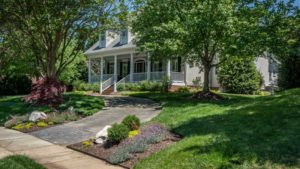How do I improve the drainage in my yard? It is a fairly common question here in the Charlotte area. Even though a lot of yards are built with slopes, that doesn’t mean the builder or the previous owner set up the drainage in the yard to work the best. In fact, sloping yards can actually cause drainage problems, because all that water eventually ends up in a low-lying area.
Common Problems with Poor Lawn Drainage
Poor drainage in your lawn can lead to a lot of cosmetic problems, but it can also cause more serious ones. Too much water isn’t good for most plants or building materials. Here are just a few of the issues that improper drainage can result in.
- Yard Puddling
- Yard Flooding
- Dead Grass
- Dead Landscape Plants
- Basement or Crawl Space Moisture
- Foundation Issues
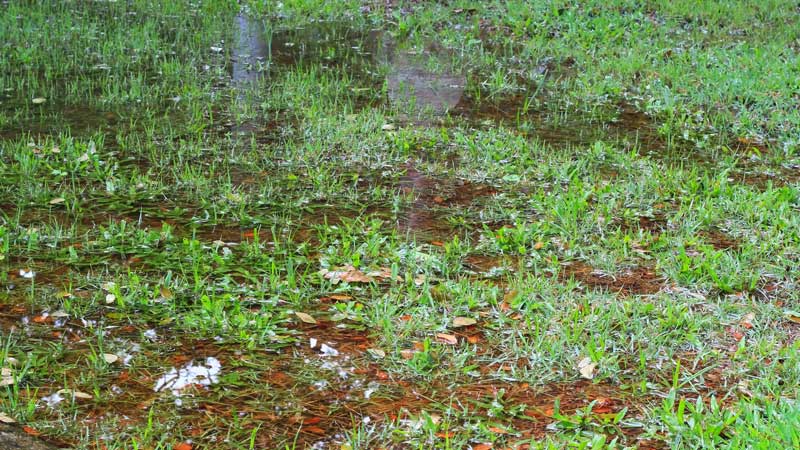
Problems with Puddles in Your Yard
Puddles in your yard make it hard to use. They keep your kids off the lawn and in the house, make a mess of your dog and generally reduce the enjoyment of your outdoor living space.
If you have standing water more than 1/2 hour after a heavy rainfall, then you have puddling problems in your yard. Common reasons for puddles are low spots in your yard. If the puddles are not that large, you can probably add a little topsoil or sand to build the area up and see if that solves the problem.
If you have large puddles that stay there for days after a rain, then you have a more complex problem that is probably in need of a drainage system.
Problems with Yard Flooding
If your side or backyard fills up with water when it rains hard and turns it into a marsh, then you’ve got more serious problems than just puddles. There may be grading issues or too much water flow from your downspouts or even a neighbors property. This type of problem generally requires a good drainage plan to fix.
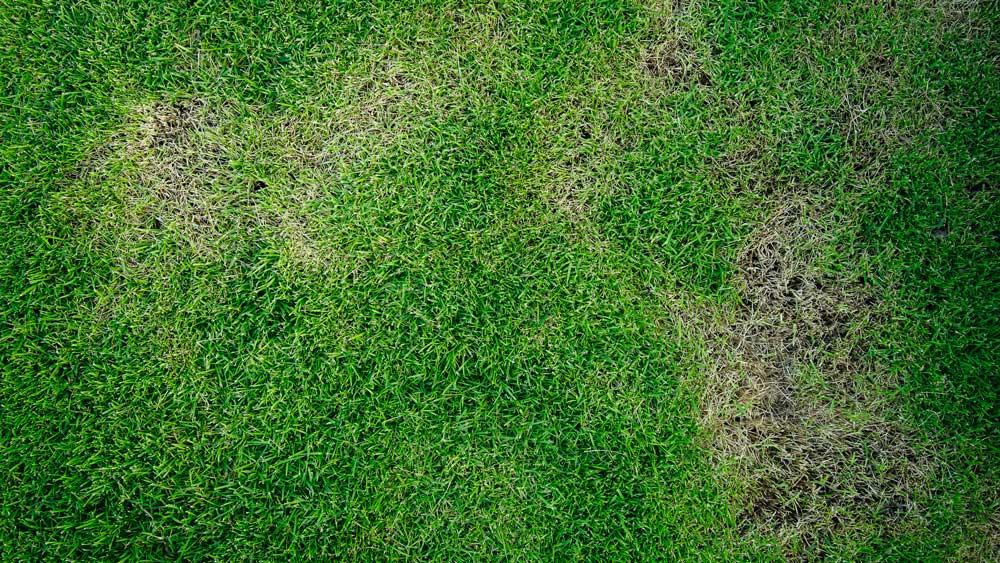
Plants and Grass Dying Mysteriously?
If you are having trouble keeping grass growing or landscaping plants alive in some areas of your yard, too much water may be the reason. Zoysia grass, for example, is very intolerant of bad drainage due to a fungal disease that thrives in overly wet environments.
Many landscape plants will suffer if they are in too wet of soil. The roots will rot and the plant will be unable to send oxygen and nutrients throughout the plant.
If you are having problems with your grass not growing well (and it isn’t under a shade tree) or you have ill or dead landscape plants, poor drainage in your yard may be the problem.
Worst-Case Scenario – House Damage
Here’s the worst-case scenario when it comes to water in your yard. That standing water next to the foundation causes foundation damage. Or the water stands in your crawl space and causes mold, leading to health problems for your family.
Drainage issues that threaten the house are a real concern, especially if your neighborhood is built on slopes that channel water down from one yard to the next. We often find standing water near the foundation on the side of the house that is downhill from the neighbors. Some regrading or a french drain is often the solution to fix these problems.
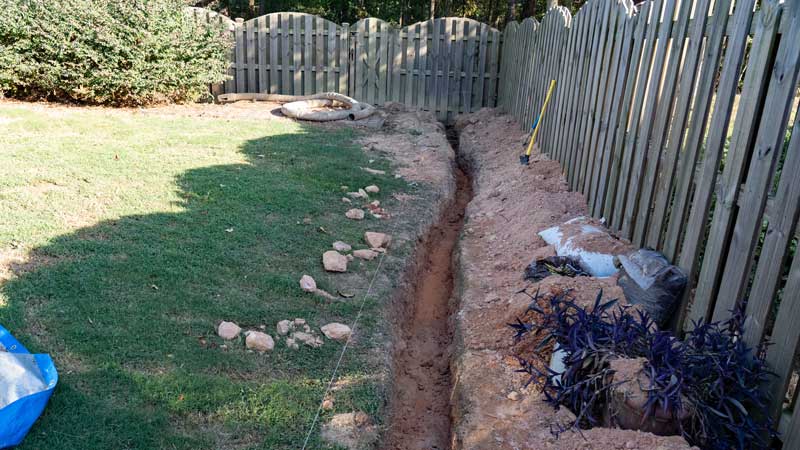
Drainage Solutions
There are a number of different drainage solutions, depending on the scope of your problem. The best way to determine the correct approach is to have a landscaping company come out and look at your property to see where the problem is and which solutions will be most appropriate. Here are some of the solutions that we commonly use when taking on yard drainage problems.
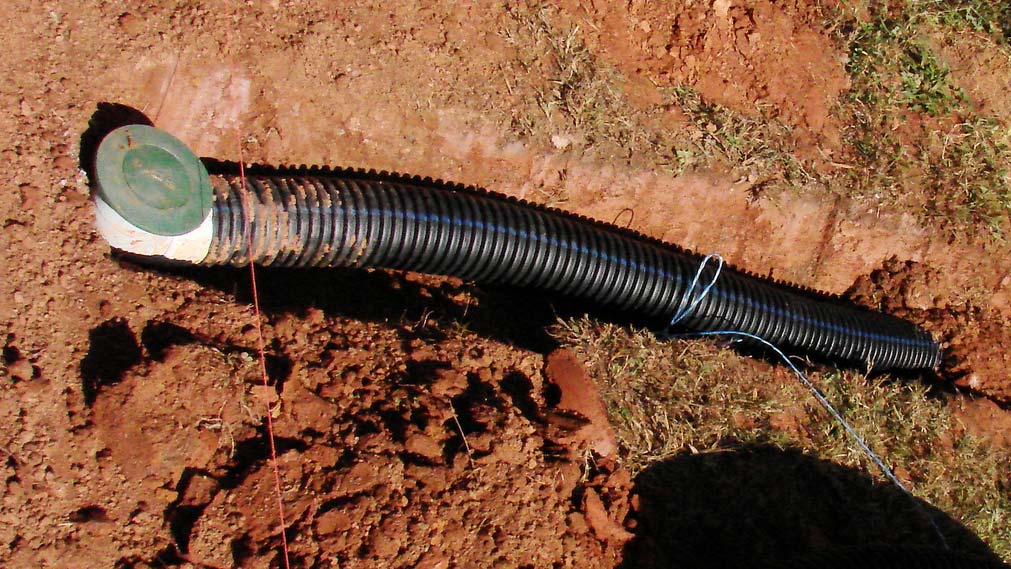
Downspout Redirection
Downspouts can channel a lot of water, especially if you have a large roof surface. When you get a heavy rain, having a short downspout can leave a lot of water puddling next to your foundation. A simple solution you can try yourself is to get a downspout extender from the local hardware store and attach it to your downspout. This will allow you to redirect the water further away from your foundation, patio or another area that is getting too much water.
If that fails, then draining the downspout underground is a potential solution. Using corrugated plastic tubing allows some of the water to enter the soil underground as it travels to the end of the tube. This method works well if you have some slope to your yard because you can redirect the water through an underground tube and allow it to drain out further downhill and in a spot that leads to better overall drainage.
Depending on your situation, this may be combined with a french drain or a dry well to move all that roof water someplace where it won’t be a problem.
Swales
Sometimes moving the dirt around in your yard is a good solution to your water issues. This might be some minor regrading along your foundation or patio to allow the water to flow away from it, or it could be the creation of a swale.
Swales are essentially channels for water to run down. They can be fairly non-obvious because they don’t require a major slope to be effective and can be covered in grass. Grass will slow the water flow some, but if done right it can still prevent puddling and flooding. A swale is a fairly natural way to direct water to a drain or area where some extra water isn’t a problem.
Dry Well
A dry well is a container that is designed to hold stormwater from your yard, then slowly letting it drain into the yard. Dry wells can be used to collect the water from several downspouts or drains in your yard to make them more effective.
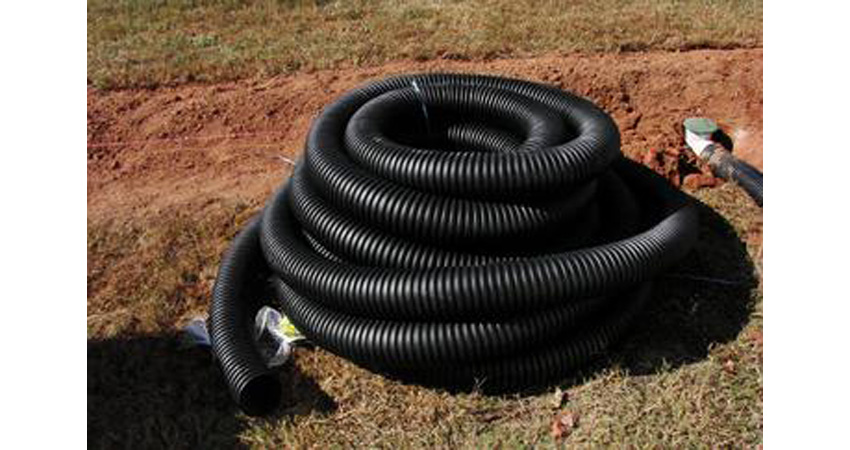
French Drain
French drains are a very common way to fix drainage problems around structures. In addition to building foundations, they are commonly used along retaining walls to relieve water pressure that could cause the wall to collapse.
A French drain uses corrugated tubing and rock in a trench to move water away from areas where it may cause damage. It is pretty common to see neighborhoods in the Charlotte area set on hills, where each house is a few feet downhill from the last one. If a swale is not designed correctly, the water will both rush and seep through the ground down the hill, until it comes to the foundation of the next house. A classic use of the french drain is to install it in this situation to channel all that water somewhere else.
If you are experiencing crawl space or basement moisture problems, a French drain is often an external solution to keep water away from the house.
Your Drainage Plan
Solving your drainage problem might be fairly straightforward. In other cases, it might require using several of these tactics. Having a professional look over your drainage problem is a smart way to get started with a drainage plan.
If you have a home or business in the Charlotte area that has a drainage problem, we can help. We’ve designed and installed drainage solutions for all types of yards over the past 30 years. Contact us to get started.

